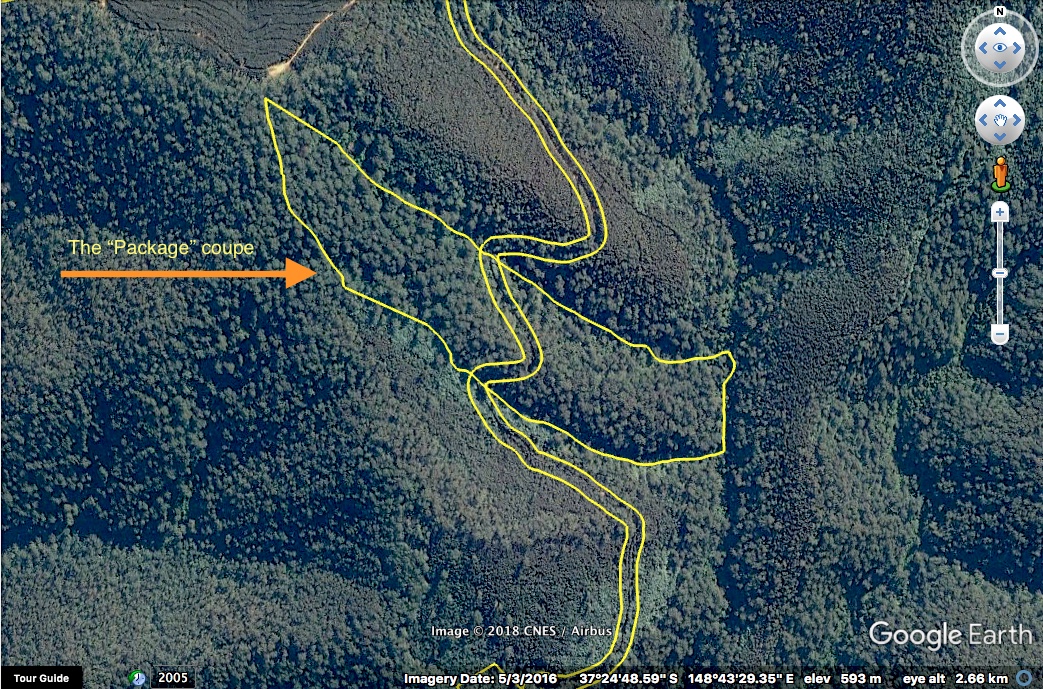Surveys conducted last year during GECO citizen science camps have resulted in protection of three proposed logging coupes that provide habitat for Endangered Orbost Spiny Crayfish and Greater Gliders.
The environment department wrote to GECO and the Fauna and Flora Research Collective last week informing us that new protections will be put in place in light of our survey results.

During our citizen science camp in January 2017, surveys for Orbost spiny crayfish were conducted in the forests of 'Ferntree' in the Ellery forest block. Endangered Orbost Spiny Crayfish (Eustacus diversus) were recorded in streams along the northern and southern boundaries of the proposed logging area or coupe.

Citizen science camp participants in the Ellery forest block, January 2017
Orbost Spiny crayfish are listed as Endangered on the Victorian Flora and Fauna Guarantee Act. When a Spiny Crayfish is found in a stream the law requires a protection zone to be established. The protection zone provides a 100m buffer on the stream that the Cray has been found in. The required buffer extends 1km upstream and 1km downstream of the the location where the Crayfish was detected.

Orbost Spiny Crayfish (Euastacus diversus)
The protection measure is designed to prevent sedimentation of streams. Logging operations cause sediment to wash into streams leading to changes in the flow characteristics and water quality which can reduce habitat quality and size.
The International Union for Conservation and Nature (IUCN) lists the Orbost Spiny Crayfish as Endangered on the IUCN Red List, citing sedimentation from logging as a threatening process.
The proposed coupe is known to VicForests as "Package". It is 28 hectares in size (about 17 MCG sized football fields).
 The entire area of the coupe is old growth forest, it has never been logged. It is beautiful wet forest, rich in vines tall tree ferns and large old gum trees. Watercourses that provide good habitat for the Orbost Spiny Crayfish are present on the northern and southern boundaries of the coupe.
The entire area of the coupe is old growth forest, it has never been logged. It is beautiful wet forest, rich in vines tall tree ferns and large old gum trees. Watercourses that provide good habitat for the Orbost Spiny Crayfish are present on the northern and southern boundaries of the coupe.
The required 100m buffers on the streams will now prevent logging in this coupe.
This logging coupe is one of 34 coupes currently subject to a Supreme Court case run by the Fauna and Flora Research Collective (FFRC) against the environment department. The FFRC are arguing that DELWP has failed to meet obligation requiring them to protect old growth forest. The FFRC were seeking protection of this forest through the case, but it looks like it will now be protected regardless.
It's a great result for this area of old growth forest and the Crayfish and another example of the value of GECOs citizen science work. This coupe was surveyed by VicForests but their surveys failed to find any crayfish in the streams.
Thankfully the GECO survey team stepped in and conducted a proper survey and the forest is now safe!
Read the Crayfish report GECO submitted to the environment department here
To make a tax deductible donation to support our work click here.
Greater Gliders at Bendoc River to be protected after Fauna and Flora Research Collective surveys
A 100 hectare protection zone will be established by the environment department to protect a population of Greater Gliders reported by the Fauna and Flora Research Collective.
The FFRC survey recorded 28 Greater Gliders over a distance of approximately 2.4 km.
 In East Gippsland a protection zone is required to be put in place when more than 10 Greater Gliders are found over a distance of 1km. This protection threshold is hard to meet as it was created over 20 years ago when the species was common. If less than 11 Gliders are found, say 9 or 10, no protections are implemented and their habitat is logged.
In East Gippsland a protection zone is required to be put in place when more than 10 Greater Gliders are found over a distance of 1km. This protection threshold is hard to meet as it was created over 20 years ago when the species was common. If less than 11 Gliders are found, say 9 or 10, no protections are implemented and their habitat is logged.
Greater Glider populations in far East Gippsland have declined by 55% in the last 20 years, according to the environment deparment's (DELWP) own data.
Thankfully the FFRC were able to find enough Gliders in the Bendoc river forests to trigger a protection zone and this population will be kept safe from logging, unlike the Gliders in the Queensborough rover forests, where FFRC surveys recorded 11 gliders in 1km but department refused to protect the area and allowed logging to continue.
Read the FFRC survey report here.
The forest here is Tablelands damp forest and rare Montane grassy woodland (a listed vulnerable ecological vegetation class). The forest is in close proximity to the northern boundary of the Errinundra National Park and the new protection zone will provide important additional protection for Greater Gliders that will hopefully link to the existing park.